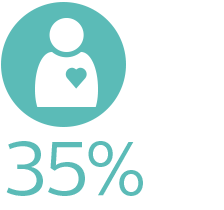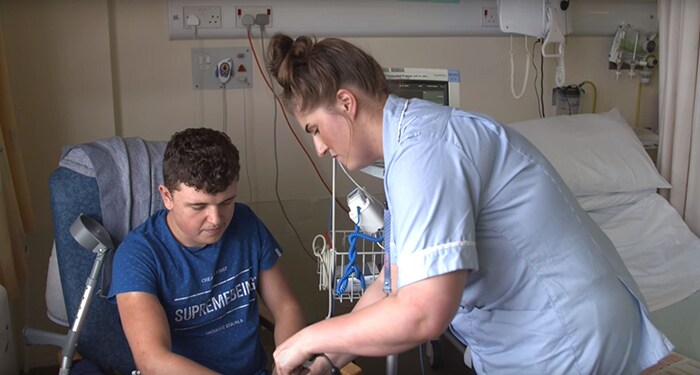Do your caregivers have the information they need to identify subtle signs of patient deterioration early? The indications of a patient’s clinical instability typically occur six to eight hours before an event. An automated early warning scoring (EWS or MEWS) solution can help you identify the subtle signs of deterioration that can indicate a potential serious adverse event (SAE) and automatically re-check those warning signs, using Philips reassurance measurements, to determine if a notification needs to be sent to the appropriate caregivers. By reducing the need for manual record keeping and associated manual scoring calculations, automated EWS can help you identify patients at risk, reduce response times and put time back on your side. Early detection of patient deterioration (and appropriate notification of caregivers) gives you more time to respond and plan appropiate intervention. EWS can support this. Automated EWS can support making this easy. Ask us about automated early warning solutions for your hospital.
See how automated early warning scoring works to acquire vital signs, calculate a score, and notify responsible caregivers to intervene quickly.

IntelliVue Guardian
Automated early warning scoring system combines vital signs monitoring and software for early identification of patients at risk for deterioration.

EWS education and training
Get started on an EWS program or optimize your processes in place to enable your caregivers to react and respond before an adverse event.
Build your system,
your way
The best early warning scoring solution is one that integrates easily into your existing infrastructure and IT environment to simplify staff communications, streamline workflow, support document compliance, meet Joint Commission goals for standards of care, and improve patient care. Philips can deliver the products, services, and expertise to build an EWS solution designed to help you meet your goals. Contact us to arrange a consultation with a Philips representative who can help you build an EWS solution designed around your organization.
Automated EWS makes a significant difference
A study using Philips IntelliVue GuardianSoftware supports the use of an automated EWS system with notifications to provide significant improvements in key patient centered clinical outcomes.1

reduction in hospital mortality, including readmissions1

reduction of Severe Adverse Events1

reduction in ICU mortality of patients transferred to the ICU1

reduction of Cardiopulmonary Arrests1
See the positive economic impact that Early Warning Scoring systems can make at your hospital
Success in implementation
General Hospital in Bangor, UK, reports a reduction in serious events by more than a quarter, a 74% reduction of ICU mortality of patients transferred to the ICU, and a
cardiac arrest reduction of more than 80% by incorporating Philips IntelliVue GuardianSoftware1.
See how Philips early warning scoring technology led to a clinically significant reduction in patient codes, and no codes in the orthopedic unit, in the four years since installation at Saratoga Hospital in New York.
At Bagan Specialist Center, a private hospital in Butterworth, Malaysia, Philips Patient Deterioration Solution was implemented to support vital signs monitoring in general care wards as a part of a hospital expansion project, supporting the reduction of code blue incidences by more than 50%.
Sana Klinikum Lichtenberg in East Berlin introduced the use of Philips Patient Deterioration Solution on its general surgery floor with the goals of improving patient care and staff satisfaction. Sana often has a need to monitor our patients continuously and intensively during their first few days back on the ward and Early Warning Scoring is a tool we can use to detect changes to our patients' vital parameters in good time.
Children’s Hospital of Georgia uses Philips’ automated early detection and warning solution to improve pediatric patient deterioration response. With the implementation
of the Philips system, Children’s saw a 75% decrease in pediatric early warning scoring (PEWS) inaccuracies on its pediatric medicine floor and was able to eliminate inaccuracies on its pediatric surgery floor. In addition, the Pediatric Medicine floor saw an 80% increase in pediatric emergency response team escalations, allowing clinical teams to provide timely, critical interventions for patients in need.
Why EWS? Consider the facts
63%
of preventable deaths are attributable to failure to rescue by a registered nurse or physician.2
Problem: It’s hard to predict which patients to watch closely Solution: IntelliVue Guardian EWS helps you identify subtle signs that can indicate a potential deterioration
70%
of cardiac patients show evidence of respiratory decline within eight hours of cardiac arrest3
Problem: An MD is notified only 25% of the time4
Solution: IntelliVue Guardian incorporates respiratory measurements into EWS to initiate timely intervention
150k
in-hospital cardiac arrests annually in the U.S.5
Problem: Most deteriorating patients are identified within 15 minutes – often too late to intervene
Solution: EWS tools can support improving the effectiveness of your Rapid Response Teams (RRT)
Philips general care solutions
Every respiratory measure matters

The general care floor encompasses a wide range of patients with varying conditions and needs. We work with you to identify solutions to help in identifying potential patient deteriorations and tailor them to your organization’s needs and goals.

Accurate assessment and consistent reporting of respiratory rate is extremely important to detect patient deterioration early. However, manually measuring respiratory rates can be
References Results from case studies are not predictive of results in other cases. Results in other cases may vary. 1. Subbe, C.P., Duller, B. & Bellomo, R. Crit Care (2017) 21: 52. grant from Philips 2. HealthGrades, Inc: Third Annual Patient Safety in American Hospitals Study. April 2006 3. Schein, RM, 4. Sharek PJ, Parast LM, Leong K, et al. Effect of a rapid response team on hospital-wide mortality and code rates outside the ICU in a children’s hospital, JAMA 2007; 298(19)2267-2274. 5. Franklin C, Matthew J Developing strategies to prevent in-hospital cardiac arrest: analyzing the responses of physicians and nurses in the hours before the event, Crit Care Med. 1994:22(2):244-247. 6. Mok, W et al. Attitudes towards vital signs monitoring in the detection of clinical deterioration: scale development and survey of ward nurses. Int J Qual Health Care (2015) 27 (3): 207-213.






